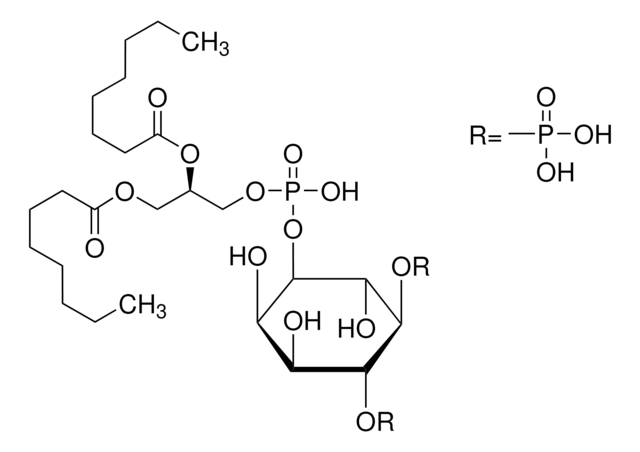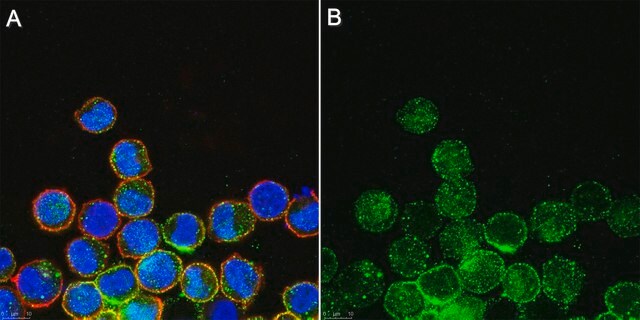524644
L-α-Phosphatidyl-D-myo-inositol-4,5-bisphosphate, Triammonium Salt, Porcine Brain
A component of membrane-bound receptors in association with phospholipase C (PLC).
Sinónimos:
L-α-Phosphatidyl-D-myo-inositol-4,5-bisphosphate, Triammonium Salt, Porcine Brain, PIP₂
About This Item
Productos recomendados
Quality Level
assay
≥98% (TLC)
form
solid
manufacturer/tradename
Calbiochem®
storage condition
OK to freeze
desiccated (hygroscopic)
protect from light
color
white to off-white
solubility
water: 10 mg/mL
chloroform: 50 mg/mL
shipped in
wet ice
storage temp.
−70°C
InChI
1S/C47H85O19P3.3H3N/c1-3-5-7-9-11-13-15-17-19-20-22-24-26-28-30-32-34-36-41(49)63-39(37-61-40(48)35-33-31-29-27-25-23-21-18-16-14-12-10-8-6-4-2)38-62-69(59,60)66-45-42(50)43(51)46(64-67(53,54)55)47(44(45)52)65-68(56,57)58;;;/h11,13,17,19,22,24,28,30,39,42-47,50-52H,3-10,12,14-16,18,20-21,23,25-27,29,31-38H2,1-2H3,(H,59,60)(H2,53,54,55)(H2,56,57,58);3*1H3/b13-11-,19-17-,24-22-,30-28-;;;/t39-,42?,43+,44?,45-,46?,47?;;;/m1.../s1
InChI key
GAIOWTITBYPFJE-JVILRMJCSA-N
General description
Note: This product is not to be used for animal treatment, in vivo research or in any other contact procedure with livestock.
Biochem/physiol Actions
Brain phospholipase D (PLD)
Packaging
Warning
Reconstitution
Other Notes
Shyng, S.-L., and Nichols, C.G. 1998. Science 282, 1138.
Mazzotti, G., et al. 1995. J. Histochem. Cytochem. 43, 181.
Liscovitch, M., et al. 1994. J. Biol. Chem. 269, 21403.
Chauhan, A., et al. 1991. Biochem. Biophys. Res. Commun. 175, 852.
Williamson, J.R. 1986. Hypertension 8, 140.
Berridge, M.J., and Irvine, R.F. 1984. Nature312, 315.
Legal Information
Storage Class
11 - Combustible Solids
wgk_germany
WGK 3
flash_point_f
Not applicable
flash_point_c
Not applicable
Certificados de análisis (COA)
Busque Certificados de análisis (COA) introduciendo el número de lote del producto. Los números de lote se encuentran en la etiqueta del producto después de las palabras «Lot» o «Batch»
¿Ya tiene este producto?
Encuentre la documentación para los productos que ha comprado recientemente en la Biblioteca de documentos.
Nuestro equipo de científicos tiene experiencia en todas las áreas de investigación: Ciencias de la vida, Ciencia de los materiales, Síntesis química, Cromatografía, Analítica y muchas otras.
Póngase en contacto con el Servicio técnico








